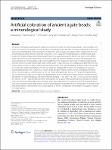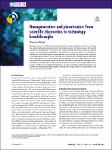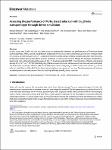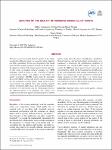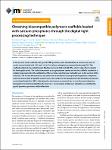Search
Author
- Manyk, T. (3)
- Murawski, K. (3)
- Baumgartner, Jörg (2)
- Guizani, Chamseddine (2)
- next >
Subject
Date issued
- 2023 (187)
Has File(s)
- true (187)
Search Results
MOFs have considerable adsorption capacity due to their huge specific surface area. They have the characteristics of photocatalysts for their organic ligands can absorb photons and produce electrons. In this paper, the photodegradation properties of TiO2 composites loaded with UiO-66 were investigated for the first time for MO. A series of TiO2@UiO-66 composites with different contents of TiO2 were prepared by a solvothermal method. The photocatalytic degradation of methyl orange (MO) was performed using a high-pressure mercury lamp as the UV light source. The effects of TiO2 loading, catalyst dosage, pH value, and MO concentration were investigated. The results showed that the degradation of MO by TiO2@UiO-66 could reach 97.59% with the addition of only a small amount of TiO2 (5 wt... |
The resulting microstructure after the sintering process determines many materials properties of interest. In order to understand the microstructural evolution, simulations are often employed. One such simulation method is the phase-field method, which has garnered much interest in recent decades. However, the method lacks a complete model for sintering, as previous works could show unphysical effects and the inability to reach representative volume elements. Thus the present paper aims to close this gap by employing molecular dynamics and determining rules of motion which can be translated to a phase-field model. The key realization is that vacancy absorption induced motion of grains travels through a grain structure without resistance. |
The process of staining was frequently employed to enhance or alter the color of agate beads in ancient times. One of the key challenges in studying ancient beads is comprehending the intricate techniques employed to color agate stones. An understanding of the staining mechanism from a mineralogical standpoint offers insights into the level of technological advancement in different civilizations. In this study, the mineral structure of eight ancient agate beads from Xinjiang Uygur Autonomous Region, NW China, was analyzed using Micro X-ray fluorescence (µXRF), Raman spectroscopy, Scanning Electron Microscope (SEM), and Fourier Transform Infrared (FTIR) techniques. The color, transparency, mineral phase, and surface roughness of the beads were examined, revealing variations ranging f... |
Nanogenerators is a field that uses the piezoelectric and/or triboelectric effect for converting low-grade mechanical energy (termed as high-entropy energy) into electric power, with a great potential for applications in the Internet of Things, self-powered sensors, robotics, medical science, and even artificial intelligence. Piezotronics is a field that utilizes the piezoelectric polarization in third-generation semiconductors for controlling the charge-carrier transport in semiconductor devices. These two fields were first coined by Wang’s group in 2006 and 2007, respectively. This article reviews the background and initial ideas based on which we introduced the following original discoveries and effects: piezoelectric nanogenerators; triboelectric nanogenerators; self-powered sen... |
The wear tests are conducted on bending punches deposited with PVD CrN and AlTiCrN coatings using the newly proposed progressive die. Then, the surface quality of the formed product is characterized through the surface roughness measurement after forming of TRIP1180 steel sheets. The correlation between the tool wear, in terms of wear depth and roughness and the product surface roughness can be quantitatively analyzed. The results show that the roughness remains comparable to that of the as-received surface before failure occurs, which represents smooth product surface without severe scratches and defects. While micro scratches on the punch surface have no effect on the quality of the product surface, severe fretting wear on the punch surface leads to a deterioration in the surface ... |
In this study, the SCAPS-1D tool has been used to numerically examine the performance of Transition Metal Dichalcogenides (TMDC) based Molybdenum ditelluride (MoTe2) solar cells containing CdS electron transport layer (ETL) and Cu2O hole transport layer (HTL). Based on the photovoltaic cell parameters, including absorber layer thickness, temperature, defect density, the effects of series and shunt resistance, and electron affinity, the structure of both MoTe2 based solar cells with and without the usage of the HTL has been analyzed. With 1.1 μm thickness of MoTe2 and doping density of 5 × 1015 cm−3, Al/FTO/CdS/MoTe2/Cu2O/Ni heterojunction’s solar cell proposed structure has been optimized. The final power conversion efficiency (PCE) = 32.38%, open-circuit voltage (Voc) = 1.07 V, sho... |
Previous research revealed that the quality of the ingots produced by different primary or secondary alloy suppliers can differ remarkably. In this way, the quality of the liquid metal and the castings produced from it can be affected by the impurity content of the ingots used as charge material. In this work, a modified reduced pressure test (RPT) technique, which is based on the remelting of samples extracted from ingots, was applied to investigate the quality of primary AlSi9Mn ingots made by horizontal direct-chill (HDC) casting and gravity casting techniques. For the evaluation of metal quality, image analysis of the cross sections was applied. Pore area fraction, number density, normalized bifilm index, and normalized total pore perimeter were determined, and the relationships... |
This paper celebrates the 75-year history of the OSU Welding Engineering program. It includes a brief history of the program, details regarding the academic mission, and current research activities. It also provides an outlook for the program into the future. |
Detailed studies of interfacial gas-phase chemical reactions are important for understanding factors that control materials synthesis and environmental conditions that govern materials performance and degradation. Out of the many materials characterization methods that are available for interpreting gas–solid reaction processes, in situ and operando transmission electron microscopy (TEM) is perhaps the most versatile, multimodal materials characterization technique. It has successfully been utilized to study interfacial gas–solid interactions under a wide range of environmental conditions, such as gas composition, humidity, pressure, and temperature. This stems from decades of R&D that permit controlled gas delivery and the ability to maintain a gaseous environment directly within t... |
In the present work, scaffolds with gyroid TPMS geometry were obtained from a commercial resin of acrylic nature loaded with 0.5% and 1% w/V of calcium phosphate nanoparticles through DLP. The scaffolds obtained presented Young's Modulus between 300 and 400 MPa, which makes them suitable for bone applications. The surface treatment by oxygen plasma carried out on the scaffolds resulted in a notable improvement in the wettability of the surfaces, which favours cell adhesion on the surface of the materials. The in vitro bioactivity assay conducted on the resin/calcium phosphate particles composite material showed that an apatitic layer forms on the surface of the samples from the third day of exposure to simulated body fluid (SBF), indicating that the composite material has in vitro b... |



